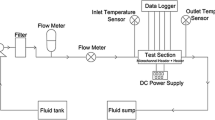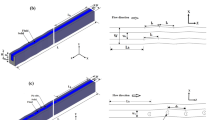Abstract
To solve the heat dissipation problem of electronic devices with high heat flux hotspots, a diamond microchannel heat sink consisting of 37 parallel triangular microchannels with channel lengths of 45 mm and hydraulic diameters of 280 μm was designed. The flow boiling heat transfer characteristics of ammonia in the microchannels were investigated under high heat fluxes of 473.9-1000.4 W/cm2. Saturated flow boiling experiments with saturation temperatures of 25, 30, and 35°C and mass fluxes of 98–1200 kg/m2s were conducted, as well as subcooled flow boiling with inlet subcooling of 5°C as a comparison. The temperature and pressure drop measurements were analyzed, and the main conclusions below can be drawn. (1) At a given heat flux, the heat source temperature first decreased and then increased with the mass flux, and there existed an optimum mass flux to optimize the cooling performance of the heat sink. (2) The heat transfer performance under the saturated inlet condition was obviously better than that under the subcooled inlet condition. (3) A larger saturation temperature leaded to weakening of both the heat transfer capacity and the stability of the microchannel heat sink. Notably, with the high heat diffusion ability of the diamond substrate and the great heat transfer capacity of ammonia flow boiling in microchannels, the heat sink can achieve a heat removal capacity of up to 1000.4 W/cm2.
Similar content being viewed by others
References
Kovaes G.T.A., Micro machined transducers source book. McGraw-Hill: New York, 1998.
Bar-Cohen A., Maurer J.J., Sivananthan A., Near-junction microfluidic thermal management of RF power amplifiers. 2015 IEEE International Conference on Microwaves, Communications, Antennas and Electronic Systems, 2015, doi: https://doi.org/10.1109/COMCAS.2015.7360498.
Peterson G.P., An introduction to heat pipes-modeling testing and application. New York: JOHN WILEY&SONSINC, 1994.
Ebadian M.A., Lin C.X., A review of high-heat-flux heat removal technologies. Journal of Heat Transfer, 2011, 133(11): 110801–1–110801–11.
Campbell G., Eppich H., Lang K., et al., Advanced cooling designs for GaN-on-Diamond MMICs. ASME 2015 International Technical Conference and Exhibition on Packaging and Integration of Electronic and Photonic Microsystems collocated with the ASME 2015 13th International Conference on Nanochannels, Microchannels, and Minichannels, 2015, doi: https://doi.org/10.1115/IPACK2015-48429.
Chao P.C., Chu K., Diaz J., et al., GaN-on-diamond HEMTs with 11 W/mm output power at 10 GHz. MRS Advances, 2016, 1(2): 147–155.
Gambin V., Poust B., Ferizovic D., et al., Impingement cooled embedded diamond multiphysics co-design. 15th IEEE Intersociety Conference on Thermal and Thermomechanical Phenomena in Electronic Systems, 2016, doi: 10.1109/ITHERM.2016.7517729.
Altman D.H., Gupta A., Tyhach M., Development of a diamond microfluidics-based intra-chip cooling technology for GaN. ASME 2015 International Technical Conference and Exhibition on Packaging and Integration of Electronic and Photonic Microsystems collocated with the ASME 2015 13th International Conference on Nanochannels, Microchannels, and Minichannels, 2015, doi: https://doi.org/10.1115/IPACK2015-48179.
Agostini B., Fabbri M., Park J.E., et al., State of the art of high heat flux cooling technologies. Heat Transfer Engineering, 2007, 28(4): 258–281.
Xu M., Jia L., Dang C., et al., The effect of heating direction on flow boiling heat transfer of R134a in micro-channels. Journal of Thermal Science, 2017, 26(2): 166–174.
Huang Q., Jia L., Dang C., et al., Experimental study on flow boiling of deionized water in a horizontal long small channel. Journal of Thermal Science, 2018, 27(2): 157–166.
Li X., Jia L., The investigation on flow boiling heat transfer of R134a in micro-channels. Journal of Thermal Science, 2015, 24(5): 452–462.
Faulkner D., Khotan M., Shekarriz R., Practical design of a 1000 W/cm2 cooling system. Nineteenth Annual IEEE Semiconductor Thermal Measurement and Management Symposium, 2003,doi: https://doi.org/10.1109/STHERM.2003.1194366.
Kim S.J., Mckrell T., Buongiorno J., et al., Alumina nanoparticles enhance the flow boiling critical heat flux of water at low pressure. Journal of Heat Transfer, 2008, 130(4): 044501–1–044501–3.
Lee J., Mudawar I., Critical heat flux for subcooled flow boiling in micro-channel heat sinks. International Journal of Heat and Mass Transfer, 2009, 52(13–14): 3341–3352.
Kuo C.J., Peles Y., Local measurement of flow boiling in structured surface microchannels. International Journal of Heat and Mass Transfer, 2007, 50(23–24): 4513–4526.
Ko.ar A., Kuo C.J., Peles Y., Boiling heat transfer in rectangular microchannels with reentrant cavities. International Journal of Heat and Mass Transfer, 2005, 48(23–24): 4867–4886.
Bogojevic D., Sefiane K., Walton A.J., et al., Experimental investigation of non-uniform heating effect on flow boiling instabilities in a microchannel-based heat sink. International Journal of Thermal Sciences, 2011, 50(3): 309–324.
Revellin R., Thome J.R., A theoretical model for the prediction of the critical heat flux in heated microchannels. International Journal of Heat and Mass Transfer, 2008, 51(5–6): 1216–1225.
Revellin R., Quiben J.M., Bonjour J., et al., Effect of local hot spots on the maximum dissipation rates during flow boiling in a microchannel. IEEE Transactions on Components and Packaging Technologies, 2008, 31(2): 407–416.
Koo J., Jiang L., Bari A., et al., Convective boiling in microchannel heat sinks with spatially-varying heat generation. Eighth Intersociety Conference on Thermal and Thermomechanical Phenomena in Electronic Systems, 2002, doi: https://doi.org/10.1109/ITHERM.2002.1012477.
Ritchey S.N., Weibel J.A., Garimella S.V., Effects of non-uniform heating on the location and magnitude of critical heat flux in a microchannel heat sink. International Journal of Micro-Nano Scale Transport, 2014, 5: 95–108.
Ritchey S.N., Weibel J.A., Garimella S.V., Local measurement of flow boiling heat transfer in an array of non-uniformly heated microchannels. International Journal of Heat and Mass Transfer, 2014, 71: 206–216.
Alam T., Lee P.S., Yap C.R., et al., A comparative study of flow boiling heat transfer and pressure drop characteristics in microgap and microchannel heat sink and an evaluation of microgap heat sink for hotspot mitigation. International Journal of Heat and Mass Transfer, 2013, 58(1–2): 335–347.
Yin L., Xu R., Jiang P., et al., Subcooled flow boiling of water in a large aspect ratio microchannel. International Journal of Heat and Mass Transfer, 2017, 112: 1081–1089.
Moffat R.J., Describing the uncertainties in experimental results. Experimental Thermal and Fluid Science, 1988, 1(1): 3–17.
Miler J.L., Flynn R., Refai-Ahmed G., et al., Effects of transient heating on two-phase flow response in microchannel heat exchangers. Proceedings of the ASME 2009 InterPACK Conference, 2009, doi: https://doi.org/10.1115/InterPACK2009-89325.
Cho E., Koo J., Jiang L., et al., Experimental study on two-phase heat transfer in microchannel heat sinks with hotspots. Nineteenth Annual IEEE Semiconductor Thermal Measurement and Management Symposium, 2003, doi: https://doi.org/10.1109/STHERM.2003.1194369.
Agostini B., Thome J.R., Fabbri M., et al., High heat flux two-phase cooling in silicon multimicrochannels. IEEE Transactions on Components and Packaging Technologies, 2008, 31(3): 691–701.
Huang H., Thome J.R., An experimental study on flow boiling pressure drop in multi-microchannel evaporators with different refrigerants. Experimental Thermal and Fluid Science, 2017, 80: 391–407.
Choi K., Pamitran A.S., Oh J., et al., Pressure drop and heat transfer during two-phase flow vaporization of propane in horizontal smooth minichannels. International Journal of Refrigeration, 2009, 32(5): 837–845.
Pamitran A.S., Choi K., Oh J., et al., Two-phase pressure drop during CO2 vaporization in horizontal smooth minichannels. International Journal of Refrigeration, 2008, 31(8): 1375–1383.
Maqbool M.H., Palm B., Khodabandeh R., Flow boiling of ammonia in vertical small diameter tubes: Two phase frictional pressure drop results and assessment of prediction methods. International Journal of Thermal Sciences, 2012, 54: 1–12.
Author information
Authors and Affiliations
Corresponding author
Rights and permissions
About this article
Cite this article
Yang, Q., Miao, J., Zhao, J. et al. Flow Boiling of Ammonia in a Diamond-Made Microchannel Heat Sink for High Heat Flux Hotspots. J. Therm. Sci. 29, 1333–1344 (2020). https://doi.org/10.1007/s11630-019-1208-3
Received:
Published:
Issue Date:
DOI: https://doi.org/10.1007/s11630-019-1208-3




